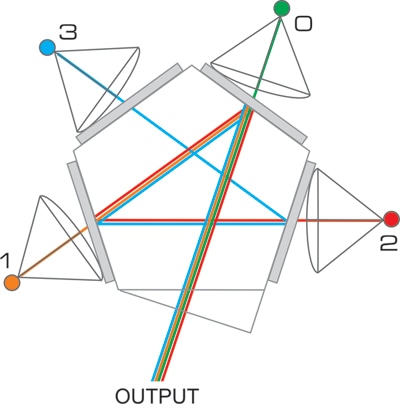The Lambda 421 beam combiner from Sutter Instruments is a new, patented, concept for combining separate light sources with different spectra into a single common output beam. Each light source is collimated before entering the optical path through a bandpass filter.
The filters for each light source also act as mirrors that reflect the collimated beams from the previous light sources. The diagram outlines the optical paths for each position including the reflections that occur:

Optical path for each light source position from 0 through 3. Image credit: Sutter Instrument
Combining more than two light sources traditionally required the use of a dichroic ladder. Combining separate light sources is enabled by dichroic mirrors, which switch from transmission to reflection at one point in the spectrum, provided that those sources do not have overlapping wavelengths.
The fact that light sources cannot be easily changed is a disadvantage of this approach.
Dichroic ladders also demand careful attention to the order in which the light sources are introduced into the optical path in order to avoid blocking of the light by the next dichroic in line.
Generally, additional bandpass filters must be added in front of each light source before the dichroic, to select the desired range of wavelengths for each source. Each dichroic and filter used in the ladder reduces the total light output of the system.
Download the Brochure for More Information
Features
- Wavelength selection and beam reflection using Semrock STR Filters
- Any suitable filter can be placed in any of 4 positions without concern for the order
- Capable of combining any light source
The design of the Lambda 421 allows the size of the beam combiner to be kept small and the optical path short and efficient. Thin-film bandpass filters, such as Semrock’s STR, reflect more than 90 % of out-of-band light. It is possible to use the filters for both attenuation and reflection of the light from the other sources, if the band pass of each light source does not overlap.
Four light sources were combined in a compact design with lower losses than previously achievable by arranging the filters and sources into a pentagon. As an extra benefit, the last position in the optical train does not require any filter, as no other input reflects from that position.
This input can be used with any sort of light source as long as users are aware of the possible losses if there are filters in use that overlap this light source. The fifth side of the pentagon becomes the output for the combined sources. The filters are effortlessly exchangeable and are installed on small sliders inside the core of the pentagon. It is also possible to arrange filters and associated light sources in any order around the pentagon.
In the diagram below the position number of the light sources is labeled based on the number of total reflections.

Image credit: Sutter Instrument
Download the Brochure for More Information